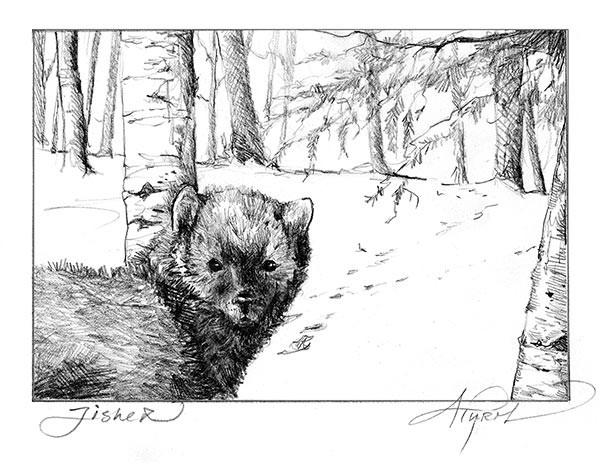
My town had the job of removing a dead beaver from a culvert pipe cage, a rather sad and odorous affair, but also an opportunity. I alerted the usual suspects – there’s nothing like a rotting carcass to bring camera trappers together – and we moved the body into the woods and set up a few cameras.
We placed the body in mature forest near the wetland. We figured that just about any of our meso-carnivores might appear: coyote, fox, fisher, and bobcat were all possibilities. We didn’t get the bobcat, but we did get the others, and the fisher photos were especially nice.
Although baiting for wildlife is not generally recommended – you need to be aware of state regulations before you move dead animals – a carcass often provides a great opportunity for game cameras. This is especially true in winter, when the body may become frozen to the ground or covered with crusty snow. It will still be detectable by wild noses, but difficult to drag away. And, of course, the larger the carcass the better, because it will last longer.
If you don’t have a bait opportunity, focus on habitat. To get more color photos, I recommend that you mount the camera in remote areas, where shy species are more likely to move around during the day. Look for areas of naturally high animal activity. Habitat features which funnel animal travel have excellent potential. The narrowest point between two bodies of water, and logs over water, are both attractive crossing areas. Stone walls cutting through a tangled forest floor and rock outcrops within dense forest also offer easy travel. Cameras carefully mounted at any of these habitat features can be very productive.
One of our favorite camera locations is a large rock outcrop in dense forest, far from noisy humans. This particular outcrop is on a hill near rugged ledges and boulders with plenty of caves and crannies for denning. When we first viewed the site, we suspected these shelters would appeal to many species, and the outcrop would funnel travel to them. Animals with no interest in the boulders and ledge might use the outcrop just for easy passage through the dense forest, or to rest and scan the surrounds. Snow tracking confirmed a high level of travel, and the cameras captured some winners: deer, moose, and bobcat passed through. A gray fox paused to scope out the surrounds. Coyote pups cavorted under the protective watch of Mom. A porcupine ambled along. And a bear examined and repositioned the camera (but thankfully did not destroy it). What’s more, many of these images were daytime photos, and the stone and conifer backdrop nicely framed the animals.
Another excellent habitat element is a beaver dam. Squirrels cache nuts and mice live within the recesses. Coyotes, foxes, and bobcats cross the dam, sometimes hunting small mammals along the way. Otters slide over them. Even a foraging porcupine will cross a beaver dam to access favorite feeding trees. And, of course, beavers inspect and maintain the dam. Mount a camera at one end of the dam, and you’re likely to see some of this activity.
Beaver wetlands are wildlife hot spots in general, and the dam isn’t the only good option for camera placement. Coyotes, foxes, otters, and mink may scat, slide, roll, or perch atop beaver lodges. In fact, just about any area of high beaver activity seems to attract other species. Active scent mounds and haul outs are good bets. While vacationing in the Adirondacks, I once placed a camera at a well-used beaver haul out. Over just four days, I got photos of beaver, coyote, deer, and raccoon. Only the beaver was hauling out; the others were just nosing around.
So get yourself a trail camera, look for high activity habitat, and use your tracking skills to find that perfect spot. It might take a little experimentation, but you’ll learn a lot about wildlife, and with time you’ll get some great photos.


Discussion *